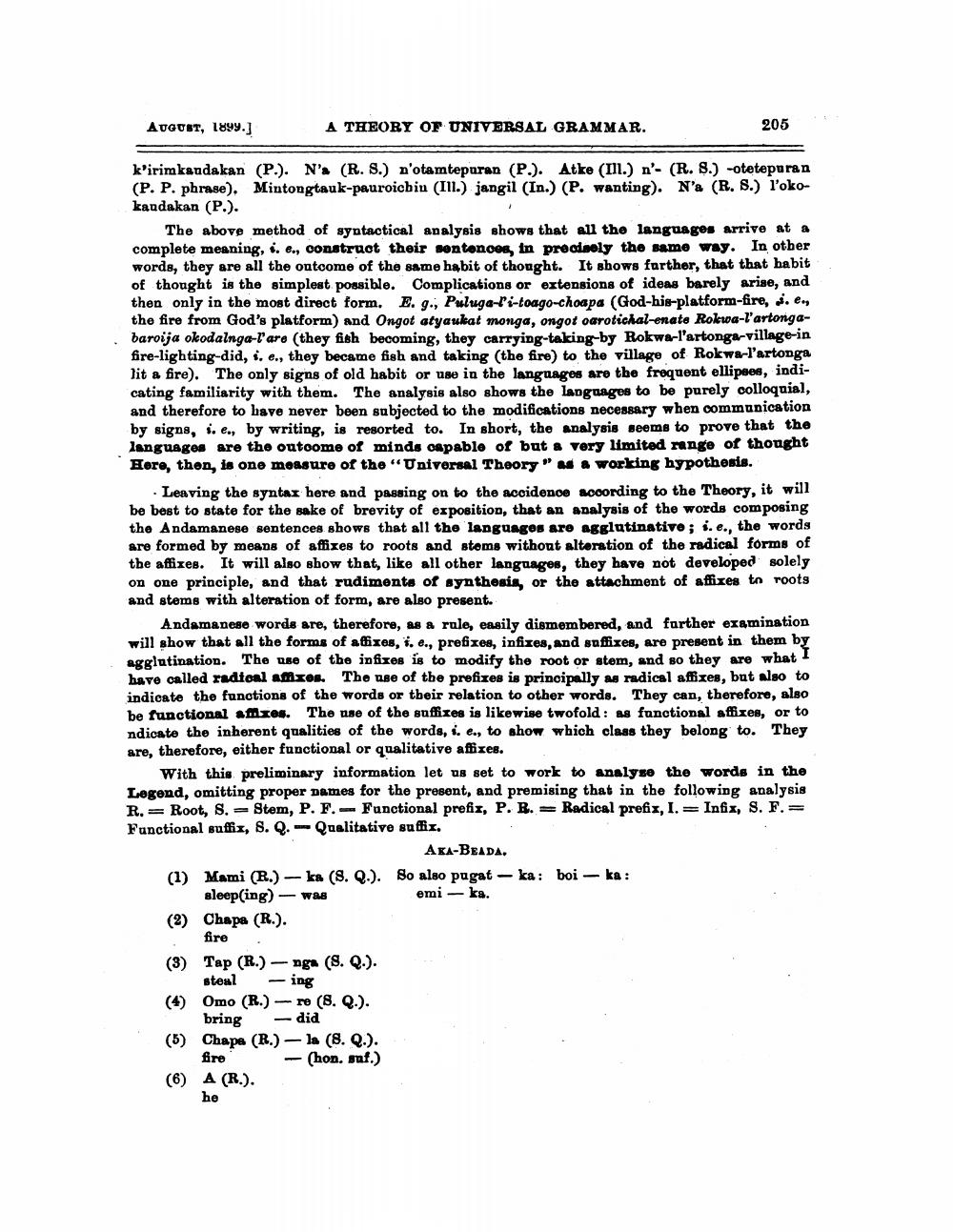________________
AUGUST, 1899.]
A THEORY OF UNIVERSAL GRAMMAR.
205
k'irimkandakan (P.). N's (R. S.) n'otamtepuran (P.). Atke (II.) n'- (R. S.) -otetepuran (P. P. phrase). Mintongtauk-pauroicbiu (I11.) jangil (In.) (P. wanting). N'a (R. S.) l'okokaudakan (P.).
The above method of syntactical analysis shows that all the languages arrive at a complete meaning, 6. e., construct their nontonoos, in precisely the same way. In other words, they are all the outcome of the same habit of thought. It shows farther, that that babit of thought is the simplest possible. Complications or extensions of ideas barely arise, and then only in the most direct form. E. g., Puluga-li-toago-choapa (God-his-platform-fire, . ., the fire from God's platform) and Ongot atyaukat monga, ongot oarotichal-enate Rolewa-l'artongabaroija okodalnga-l'are (they fish becoming, they carrying-taking-by Rokwa-l'artonga-village-in fire-lighting-did, s. e., they became fish and taking the fire) to the village of Rokwa-l'artonga lit a fire). The only signs of old habit or use in the languages are the frequent ellipses, indicating familiarity with them. The analysis also shows the languages to be purely colloquial, and therefore to have never been subjected to the modifications necessary when communication by signs, s. e., by writing, is resorted to. In short, the analysis seems to prove that the languages are the outoome of minds onpable of but a very limited range of thought Here, then, is one moasure of the "Universal Theory" & working hypothesis.
• Leaving the syntax here and passing on to the accidence according to the Theory, it will be best to state for the sake of brevity of exposition, that an analysis of the words composing the Andamanese sentences shows that all the languages are agglutinative; i.e., the words are formed by means of affixes to roots and stoms without alteration of the radical forms of the affixes. It will also show that, like all other languages, they have not developed solely on one principle, and that rudiments of synthesis, or the attachment of affixes to roots and stems with alteration of form, are also present.
Andamanese words are, therefore, as a rule, easily dismembered, and further examination will show that all the forms of affixes, *. e., prefizes, infixes, and suffixes, are present in them by agglutination. The use of the infixes is to modify the root or stem, and so they are what have called radioal amxon. The use of the prefixes is principally as radical affixes, but also to indicate the functions of the words or their relation to other words. They can, therefore, also be functional m es. The use of the suffixes is likewise twofold: as functional affixes, or to ndicate the inherent qualities of the words, i. e., to show which class they belong to. They are, therefore, either functional or qualitative affixes.
With this preliminary information let us set to work to analyse the words in the Legend, omitting proper Dames for the present, and premising that in the following analysis R. = Root, s. -Stem, P. F. - Functional prefix, P. B. = Radical prefix, I. Infix, S. F.= Functional suffix, 8. Q. - Qualitative suffix,
A KA-BEADA. (1) Mami (R.) - ka (8. Q.). So also pugat - ka: boi - ka: sleep(ing) - was
emi - ka. (2) Chapa (R.).
fire . (3) Tap (R.) – nga (S. Q.).
steal - ing Omo (R.) -r (8. Q.).
bring - did (5) Chapa (R.) – la (8. Q.).
- (hon, saf.) (6) A (R.).




